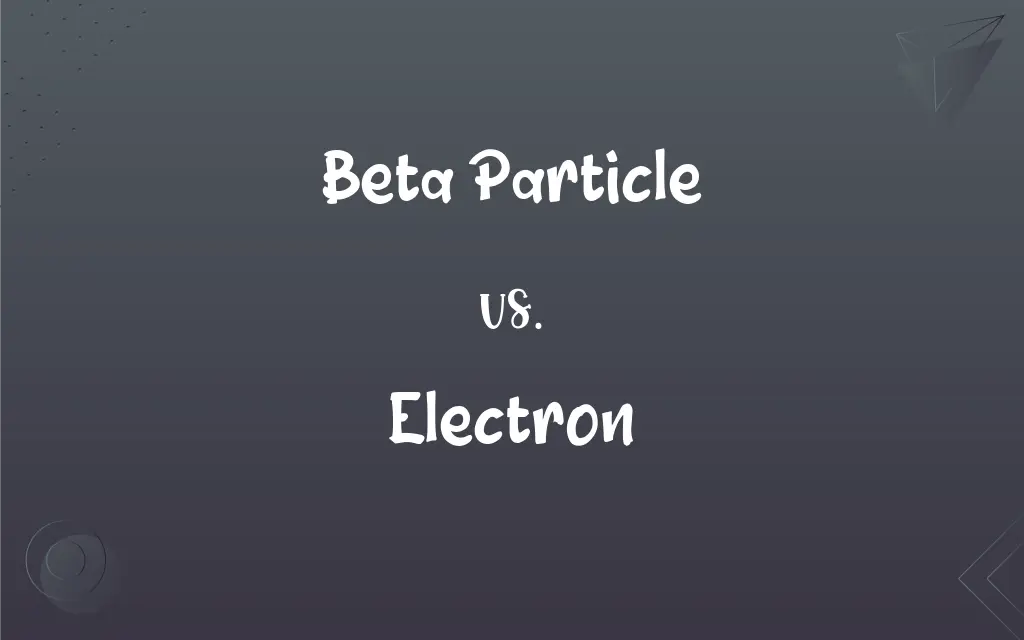Beta Particle vs. Electron: What's the Difference?
Edited by Janet White || By Harlon Moss || Published on November 26, 2023
A beta particle is a high-energy, high-speed electron or positron emitted during radioactive decay, while an electron is a stable subatomic particle with a negative charge found in all atoms.

Key Differences
Beta particles are emitted from an unstable nucleus during radioactive decay, carrying a charge of either minus (beta minus decay) or plus (beta plus decay). Electrons are stable, negatively charged particles present in the outer shells of atoms, crucial for chemical bonding.
While beta particles are a product of a nuclear reaction and can be either electrons or positrons, electrons are fundamental components of atoms and always carry a negative charge.
Beta particles have high energy and speed when emitted, capable of penetrating materials and causing ionization. Electrons, in their normal atomic state, have lower energies and are bound to the nucleus by electromagnetic force.
In beta minus decay, a neutron transforms into a proton and emits a beta particle (electron) and an antineutrino. Electrons, however, do not transform into other particles under normal conditions.
The study of beta particles is essential in understanding radioactive decay and nuclear physics, whereas electrons are fundamental to the study of chemistry, electricity, and general physics.
ADVERTISEMENT
Comparison Chart
Definition
High-energy electron or positron from radioactive decay
Stable subatomic particle with a negative charge
Origin
Emitted from unstable nuclei during decay
Present in all atoms as a fundamental component
Charge
Can be negative or positive (electron or positron)
Always negative
Energy and Speed
High energy and speed when emitted
Lower energy, bound to nucleus in atoms
Role in Physics/Chemistry
Studied in nuclear physics and radioactivity
Fundamental to understanding chemistry and electricity
ADVERTISEMENT
Beta Particle and Electron Definitions
Beta Particle
A type of ionizing radiation consisting of electrons or positrons.
Beta particles have sufficient energy to ionize atoms and molecules.
Electron
An elementary particle with a role in forming atoms and molecules.
The sharing or transfer of electrons leads to the formation of chemical bonds.
Beta Particle
A charged particle produced during the transformation of a neutron into a proton.
The detection of beta particles helps in understanding the decay process of radioactive elements.
Electron
A stable, negatively charged subatomic particle in the electron shell of an atom.
Electrons orbit the nucleus and are involved in chemical reactions.
Beta Particle
A high-speed electron or positron emitted during radioactive decay.
Beta particles can be blocked by a few millimeters of aluminum.
Electron
A subatomic particle with properties crucial to the physical and chemical properties of elements.
The number of electrons in an atom determines its chemical properties.
Beta Particle
An energetic subatomic particle ejected from a radioactive nucleus.
In beta decay, beta particles are released from the nucleus of an atom.
Electron
A fundamental particle responsible for electricity and chemical bonding.
The flow of electrons in a conductor constitutes an electric current.
Beta Particle
A particle involved in beta decay, either as an electron or a positron.
Beta particles are used in medical treatments and scientific research.
Electron
A particle with a negative charge, playing a key role in electricity and magnetism.
Electrons in magnetic fields exhibit a deflection due to their charge.
Electron
A stable elementary particle in the lepton class having a negative electric charge of 1 elementary unit (about 1.602 × 10-19 coulombs) and a mass of about 9.11 × 10-28 grams. Electrons are found in shells orbiting the nuclei of atoms and can also move freely through space as cathode rays in a cathode-ray tube or as beta particles emitted by radioactive nuclei, or flow in a current through a conducting material impelled by an electric potential difference.
Electron
(particle) The subatomic particle having a negative charge and orbiting the nucleus; the flow of electrons in a conductor constitutes electricity.
Electron
Alloys of magnesium and other metals, like aluminum or zinc, that were manufactured by the German company Chemische Fabrik Griesheim-Elektron.
Electron
Amber; also, the alloy of gold and silver, called electrum.
Electron
One of the fundamental subatomic particles, having a negative charge and about one thousandth the mass of a hydrogen atom. The electron carries (or is) a natural unit of negative electricity, equal to 3.4 x 10-10 electrostatic units, and is classed by physicists as a lepton. Its mass is practically constant at the lesser speeds, but increases due to relativistic effects as the velocity approaches that of light. Electrons are all of one kind, so far as is known. Thus far, no structure has been detected within an electron, and it is probably one of the ultimate composite constituents of all matter. An atom or group of atoms from which an electron has been detached has a positive charge and is called a cation. Electrons are projected from the cathode of vacuum tubes (including television picture tubes) as cathode rays and from radioactive substances as the beta rays. Previously also referred to as corpuscle, an obsolete term. The motion of electrons through metallic conductors is observed as an electric current. A particle identical to the electron in mass and most other respects, but having a positive instead of a negative charge, is called a positron, or antielectron
Electron
An elementary particle with negative charge
FAQs
Can beta particles be positrons?
Yes, in beta plus decay, positrons are emitted.
Are beta particles always negatively charged?
No, they can be positive (positrons) or negative (electrons).
Do electrons come from radioactive decay?
No, they are fundamental parts of all atoms.
What is a beta particle?
A high-energy electron or positron from radioactive decay.
What’s the role of electrons in chemistry?
They are essential for chemical bonding and reactions.
What determines an atom's chemical properties?
The number and arrangement of electrons.
How are beta particles detected?
Using Geiger counters or scintillation detectors.
Are all electrons part of atoms?
Yes, they are always associated with atoms.
What is an electron?
A stable, negatively charged subatomic particle in atoms.
Are beta particles dangerous?
They can be, due to their ionizing radiation.
Do beta particles have more energy than electrons in atoms?
Yes, they are typically more energetic.
Can electrons be created or destroyed?
No, they follow the law of conservation of charge.
How fast do electrons move in a wire?
They drift slowly, but the electric field propagates quickly.
What’s the charge of an electron?
It has a negative charge.
Is beta radiation used in medicine?
Yes, in certain cancer therapies and imaging.
Can beta particles be shielded?
Yes, with materials like aluminum or plastic.
How are beta particles used in research?
In studying nuclear reactions and material properties.
What causes beta decay?
Instability in the atomic nucleus.
What’s the mass of an electron?
It’s very small, about 9.11 x 10^-31 kilograms.
What happens to an electron in an electric field?
It accelerates, moving from negative to positive potential.
About Author
Written by
Harlon MossHarlon is a seasoned quality moderator and accomplished content writer for Difference Wiki. An alumnus of the prestigious University of California, he earned his degree in Computer Science. Leveraging his academic background, Harlon brings a meticulous and informed perspective to his work, ensuring content accuracy and excellence.
Edited by
Janet WhiteJanet White has been an esteemed writer and blogger for Difference Wiki. Holding a Master's degree in Science and Medical Journalism from the prestigious Boston University, she has consistently demonstrated her expertise and passion for her field. When she's not immersed in her work, Janet relishes her time exercising, delving into a good book, and cherishing moments with friends and family.






































































